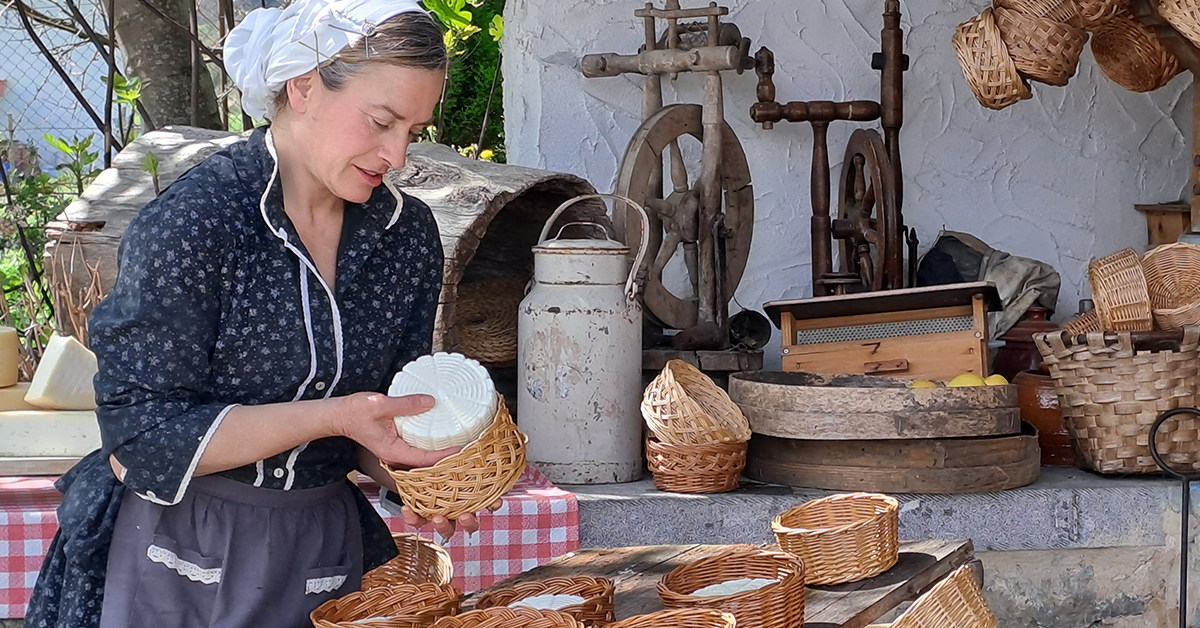Basque ethnography at a glance
Talking about traditional cheesemaking from an ethnographic standpoint subliminally brings to mind the picture of a shepherd in his hut pressing the curd into a wooden mould to extract as much whey as possible; that was at least the typical image mentioned in Gorbea, Aralar, Urbasa, Irati… and with good reason.
However, it should be noted that that was not the same everywhere. If our land is noted for something – and which makes us clearly stand out from other regions and other geographical areas – is that when it comes to analysing the methods and tools that our forebears used to make cheese, we discover that we here boasted a variety and wealth ethnographically speaking that was not found to such a diverse extent elsewhere. We just have to look at the moulds for draining the curd that were used in the past; they were made from wood (with and without a bottom, with a fixed or adjustable rim, made out of chestnut, beech, birch, etc.), ceramic, tin, wicker…
Let us now consider the latter, the wicker ones, which have become the least usual, restricted to very specific areas and are used to make what is known as “basket cheese”. As cheesemaker Leire Ibarrola in Izoria (Ayala Valley, Álava) explained, “Félix Mugurutza, a member of Euskaltzaindia, found a text from 1906, written by Barandiaran, which already described the ‘otzara’ as a cheesemaking technique, given that ‘otzara’, ‘basket’ and ‘cheesemaker’ had the same meaning; ‘otzara’ is now simply translated as ‘basket”, but ‘otzara’ was then also translated as ‘cheesemaker’”.
What is true is that the cheesemaking culture associates this type of mould made out of the product of a plant, wicker, with a cheese with a specific soft texture, lightly or not pressed, and which can be made out of ewe’s (latxa and carranzana breeds) or goat’s milk; in the past, that cheese was made in caves and in txaulak (huts), and in a geographical area that spread as far as Logroño, both from Álava and Navarra, mainly because the gypsies of the capital of La Rioja were the main – but not exclusive – suppliers of those moulds.
Thus, the cheese known colloquially as ‘basket cheese’ is found in the Carranza Valley (Bizkaia), in areas of Álava such as around Ayala (Izoria, Respaldiza, etc.), Oyón, Rioja alavesa, etc, and was even made in Viana in Navarra. It should also be noted that it was widely used, for the same reasons, in the adjoining Cameros Valley, in La Rioja.
That cheese was usually sold at Logroño market and at the one in Orduña, and from there it was taken to Vitoria and Bilbao: “My mother María Jesús and my grandmother Basilia would arrive on a mule, on a hinny, first with baskets loaded with cheeses placed between fern or cabbage leaves to protect them from being damaged as they were transported along, and then later by cart; when they reached Orduña, the ‘hagglers’ would be waiting for them and would do just that, haggle over the prices. They would buy the goods quickly to take them by train to Bilbao, to La Ribera Market, or by coach to Vitoria, to supply the cities with local produce, including basket cheese. The haggling was quick as they had to catch the train or bus, and the farmwives, including my mother and my grandmother, would stay in Orduña, selling their wares – what the ‘hagglers’ had not bought – to the townspeople, or directly delivering orders to homes; the market livened up Orduña, as if it were festivity, in the same way as on saints’ days,” reported Leire Ibarrola, from Izoria. Shepherds from Cameros and the Rioja alavesa supplied Logroño market with goods.
Finally, for information purpose, this wicker mould was called otzara in Carranza (BI) and in Ayala (A); its other names are: cestaño (Laguardia [A], Viana [NA]) and cilla (Gallinero de Cameros, in La Rioja).
Fernando Hualde – Ethnographer – Labrit Heritage




